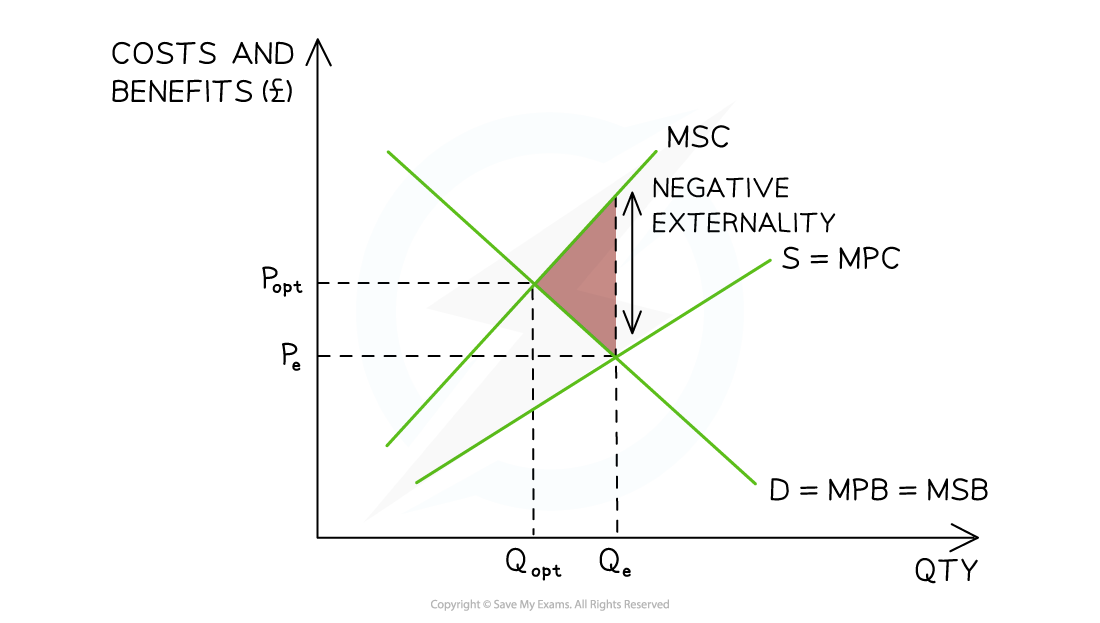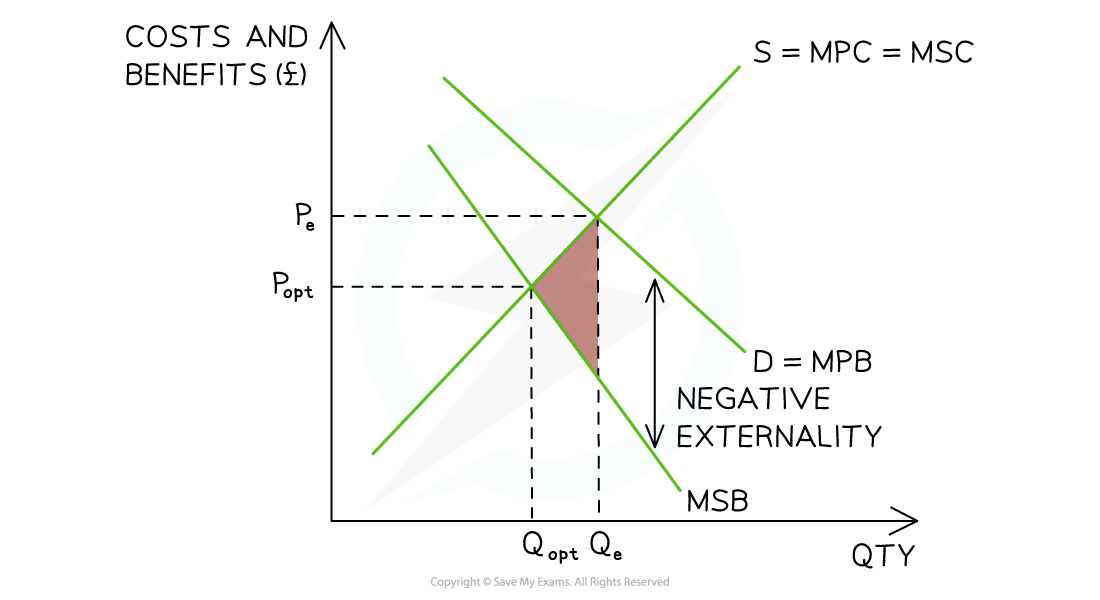Negative Externalities of Production
- Negative externalities of production are often created during the production of a good/service
- The market is failing due to over-provision of these goods/services as only the private costs are considered by the producers and not the external costs
- If the external costs were considered, the supply would decrease and they would be sold at a higher price
- Common examples include air pollution, water contamination, health problems in local communities

External costs of production (negative externality) result in an over-provision shown by the gap between Qopt and Qe
Diagram Analysis
- The marginal social benefit (MSB) is assumed to be equal to the marginal private benefit (MPB) as the focus is on the producer side of the market
- The free-market equilibrium can be seen at PeQe. This is where the MPC = MSB
- The larger the external costs in production, the larger the gap between the MPC and the marginal social cost (MSC)
- The optimum allocation of resources from society’s point of view, would generate an equilibrium where MSB = MSC
- This can be found at PoptQopt
- There is no market failure at this equilibrium
- The free market is failing due to over-provision of this good/service equal to Qe-Qopt
- The factors of production used to manufacture this over-provision represent a welfare loss to society (pink triangle)
- To be socially efficient, fewer factors of production should be allocated to producing this good/service
- There is an opportunity for government intervention (indirect taxes, legislation, regulation etc.), to force this market to be more socially efficient
- Any intervention that reduces the welfare loss will be beneficial
Negative Externalities of Consumption
- Negative externalities of consumption are often created during the consumption of a good/service e.g. the waste generated outside fast food outlets often has to be cleaned up and paid for using taxpayers' funds
- The market is failing due to over-consumption of these goods/services as only the private costs are considered by the consumers and not the external costs
- If the external costs were considered, demand would decrease and they would be sold at a lower price
- Common examples include cigarettes, alcohol, fatty foods, single-use plastic products etc.

External costs of consumption (negative externality) result in an over-consumption shown by the gap between Qopt and Qe
Diagram Analysis
- The marginal social cost (MSC) is assumed to be equal to the marginal private cost (MPC) as the focus is on the consumer side of the market
- The free-market equilibrium can be seen at PeQe. This is where the MPB = MSC
- The larger the external costs in consumption, the larger the gap between the MPB and the marginal social benefit (MSB)
- The optimum allocation of resources from society’s point of view, would generate an equilibrium where MSB = MSC
- This can be found at PoptQopt
- There is no market failure at this equilibrium
- The free market is failing due to over-consumption of this good/service equal to Qe-Qopt
- The factors of production used to manufacture this over-consumption represent a welfare loss to society (pink triangle)
- To be socially efficient, fewer factors of production should be allocated to producing this good/service
- There is an opportunity for government intervention (indirect taxes, legislation, regulation etc.), to force this market to be more socially efficient
- Any intervention that reduces the welfare loss will be beneficial
Demerit Goods
- Demerit goods are goods which have external costs in consumption
- These goods are usually addictive and harmful for consumers e.g. gambling, alcohol, drugs, sugary foods/drinks
- Governments often have to regulate these goods in such a way that they raise the prices and/or limit the quantity demanded
- The activities of producers can generate significant external costs e.g. pollution caused by coal-burning power stations during the production of electricity
- However, electricity is considered to be a merit good
- The smoke is a by-product and not a good/service
- For this reason, economists usually consider demerit goods to be goods used in consumption